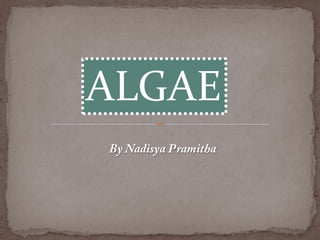
Alga
- 1. ALGAE
- 2. BODY CHARACTERISTICS Size and Shape : Algae are range in size, from the invisible (microscopic) to the visible (macroscopic) •Solitary unicellular algae Their shape are round, oval, or pear-shaped algae of this group. The example is Chlorella
- 3. •Unicellular algae in colony Cells are dependent on one another for their survival. The protoplast of each cell is connected to another by pores on the cell wall. The colony shape is like a disc, a ball, or net. The example is Hydrodictyon which have shape like a net •Multicellular algae There are forms of thread, filament, and sheet-like multicellular algae. The example is Oedogonium which have filament shape body.
- 4. BODY STRUCTURE All algae are eukaryotic organisms, their contain chloroplast. There are many shape of chloroplast . Spherical, bowl-shaped, and belt-shaped. The main pigments in algae is chlorophyll. ADDITIONAL PIGMENTS Carotene Phycobilin Fucoxanthin Xantophylls Phycocyanin Phycoerythrin (Brownish) (Golden) (Bluish) (Reddish)
- 5. REPRODUCTION PROCCESS REPRODUCTION Asexual Sexual Binary Fission Fragmentation Spore Formation
- 6. REPRODUCTION Binary Fission Binary Fission occurs only in unicellular algae. Such as Chlorella and Euglena. A mother cell divided into two to form two identical daughter cells.
- 7. REPRODUCTION Fragmentation Fragmentation occurs only in multicellular filamentous and thallus algae. Such as Spirogyra, Laminaria and Sargassum
- 10. ALGAE CHLOROPHYTA EUGLENOPHYTA CHRYSOPHYTA PHAEOPHYTA RHODOPHYTA PYRROPHYTA
- 11. EUGLENOPHYTA Euglenoids shape is like a bottle. Have disc-shaped eye spot that contains photoreceptors covered by a layer of red pigment (phycobilin). Is a unicellular organism that lacks a cell wall. Cut, the cell is covered by an elastic protein called pellicle. Euglenoid have been identified as photosyntethic organism. However, there are heterotrophic Euglenoids as well. The photosyntethic product is stored as a backup in the form of paramylon (a type of a starch). Have two flagellum. Long and short. Live in freshwater habitats such as ponds or lakes. Reproduction is done asexually by binary fission.
- 12. CHLOROPHYTA Division Chlorophyta which is popularly known as green algae, which is the largest group of algae consisting of approximately 429 genera and 6600 species. The characteristic of chlorophyta are: a. Has a pigment found in chloroplasts that are dominated by chlorophyll a and b causing this green alga b. Assimilation products in the form of starch in touch with pirenoid pembentukkannya c. Gametes have 2 or 4 flagella of equal length whiplash type located at the anterior d. Sexual reproduction isogami, anisogami, and Oogami e. Each cell has a true nucleus (no nuclear membrane) f. Cell walls composed of cellulose The example of chlorophyta (link)
- 13. CHRYSOPHYTA Have a dominant carotene pigment, xanthophyll. They are solitary unciellular algae, such as Ochromonas, or living in colony and lacking flagella, or multicellular such as Vaucheria. The cell wall of Chrysophyta contains hemicellulose, silicia, and pectin. Example : Navicula. Food in golden algae is stored as fats and carbohydrates. These algae mostly live in freshwater, with some exceptions that can live in the sea. Reproduction is done asexually by binary fission or spore formation.
- 14. PHAEOPHYTA Phaeophyta are the most complex forms of algae. The cell walls are composed of cellulose and alginic acid (a complex polysaccharide). Unlike green algae or Cholorophyta, they lack true starch. The food reserves contain sugar, higher alcohol and other complex forms of polysaccharides. The members of phaeophyta belonging to Laminarales are called kelps. Kelps are the only algae with a significant internal tissue differentiation. Though true conductive tissues like xylem and phloem are absent, kelps show some sort of conductive tissues. Speaking about the reproduction of phaeophyta, they can reproduce by means of both sexual and asexual means. Higher phaeophyta have life cycle consisting of both haploid and diploid stages, referred to as an alternation of generation. The thallus representing haploid stage and diploid stage may be similar (isomorphic) or different (heteromorphic).
- 15. RHODOPHYTA The red algae form a distinct group characterized by the following attributes: eukaryotic cells without flagella and centrioles, using floridean starch as food reserve, with phycobiliproteins as accessory pigments (giving them their red color), and with chloroplasts lacking external endoplasmic reticulum and containing unstacked thylakoids. Most red algae are also multicellular, macroscopic, marine, and have sexual reproduction. Most rhodophytes are marine, although there are freshwater species; these generally prefer clean, running water, although there are some exceptions.
- 16. PYRROPHYTA Fire Algae relates to the fact that some species living in the sea, appear fluorescent at night. Some other species are blooming certain times of the year (seasonal) and cause the appearance of red tides along the seashore. Some species can cause a toxic red tides that kill fish and sea animals. The color of the fire algae is various. Yellowish-green, green, blue, brown, or red algae depending on their pigment. Generally, the pigments of fire algae are chlorophyll a and c, xantophyll, dinoxanthin, and phycobilin. Fire algae mostly unicellular, photosynthetic organisms. Have celluloid plate on their cell wall. Usually have two flagela positioned laterally at the side or apical (at the tip) of the cell. Live predominantly in the sea and are known as the major sea phytoplankton.
- 17. Thank’s for attention
